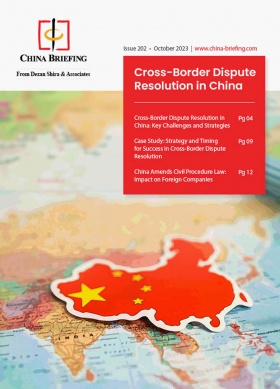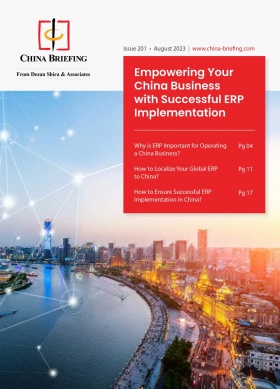China International Import Expo 2023 – Trade, Policy, and Business Opportunities
The sixth annual China International Import Expo (CIIE) is underway in Shanghai. The country’s largest annual trade fair, the CIIE attracts hundreds of the world’s leading companies to showcase their newest products and innovations to potential buyers. It is also an important stage for Chinese officials to announce policy updates related to trade and foreign investment. The US has sent its biggest-ever delegation to CIIE 2023, a strong sign of improving US-China relations, as well as the continuing draw of the Chinese market.
What is the CIIE?
The CIIE, held annually in Shanghai since 2018, is an import-focused international exhibition designed to facilitate the purchase of imported goods by Chinese companies. It is the first import-focused expo held on a national level in the world, hosted jointly by China’s Ministry of Commerce (MOFCOM) and the Shanghai Municipal Government.
The event was “personally planned, proposed, deployed and promoted” by President Xi Jinping, and is meant to demonstrate China’s commitment to further opening its markets and contribution to the world economy. It has become one of the most important events for foreign companies operating in China, offering a unique opportunity to debut new products and innovations to potential buyers.
This year marks the sixth iteration of the event which will be held from November 5 to 10 at the National Exhibition and Convention Center in Shanghai, as in past years.
There are six major product categories exhibited at the CIIE: food and agricultural products, automobile, intelligent industry and information technology, consumer goods, medical equipment and healthcare products, and trade in services.
This year’s event will host a wide range of events and activities, including policy interpretation seminars, supply-demand matchmaking events and signing ceremonies, product exhibitions, and investment promotion activities, as well as industry seminars, scientific research forums, and research outcome-sharing sessions.
The CIIE presents a major opportunity for companies seeking to enter or expand in the Chinese market to meet potential investors and strike business deals. The expo has also provided a platform for foreign brands to gain a foothold in the Chinese market for the first time.
In 2022, the value of business deals struck during the CIIE reached US$73.5 billion, up 3.9 percent from the previous year’s event despite lower attendance due to pandemic restrictions. In the first two days of the 2023 CIIE, multiple deals worth RMB 10 billion (US$1.38 billion) have already been closed.
Who’s attending CIIE 2023?
According to CIIE organizers, this year’s expo has attracted a record 289 Global Fortune 500 companies and industry leaders, with over 3,400 exhibitors and 394,000 professional visitors registered for the event. This means that attendance has returned to pre-pandemic levels.
Regular exhibitors include the likes of Tesla, BMW Group, Ferrero, Nike, FedEx, Bayer, Honeywell, Meta, and Qualcomm, among many others.
CIIE 2023 kicked off with addresses from several world leaders and foreign officials, including Australian Prime Minister Anthony Albanese, Serbian Prime Minister Ana Brnabic, Kazakh Prime Minister Alikhan Smailov, Iranian First Vice President Mohammad Mokhbern, and South African Deputy President Paul Mashatile.
The event is also attended by delegations from several international trade organizations, including the World Trade Organization (WTO), the UN Development Program (UNDP), the UN Conference on Trade and Development (UNCTAD), the International Trade Center, and the UN Food and Agriculture Organization (FAO).
The US Department of Agriculture (USDA), which is leading 17 exhibitors, has also sent a delegation this year.
Diplomacy and trade relations at CIIE 2023
Improving US-China trade relations
CIIE 2023 will see in attendance the largest and highest-level US delegation since the launch of the event in 2018. Joining the delegation are several US officials, including acting deputy under-secretary for trade and foreign agricultural affairs at the USDA Jason Hafemeister and senior adviser for North Asia at the USDA Wade Sheppard. The US has historically not sent government officials to the CIIE, making their attendance this year all the more significant.
Several other US agricultural groups and local US officials are also attending the expo. Among them is the US Heartland China Association, a private bipartisan organization that aims to build stronger ties between China and the US’ agriculture and industry-driven heartland region, which is sending a delegation of 20 state governors “to explore trade opportunities”. In addition, delegates from the American Meat Export Federation, the USA Poultry and Egg Export Council, the USA Rice Federation, and the US Cranberry Marketing Committee will also be present, per CIIE organizers.
The US delegation’s pavilion at CIIE 2023, which is co-sponsored by the USDA and the American Chamber of Commerce in China (AmCham China), will showcase agricultural products and technologies from California, Idaho, and Georgia.
China is the largest market for US agricultural products, in particular soybeans, corn, cotton, and meat products. In 2022, the US agricultural exports to China reached a total of US$40.9 billion, up 14.5 percent year-on-year according to the USDA.
The importance of the Chinese market to US agriculture makes it a pragmatic entry point to improving US-China relations and trade ties.
China and the US have been engaging in tit-for-tat sanctions and export controls ever since the Trump Administration instigated a trade war in 2018. Recent moves include US export controls on semiconductor technology to China, imposed in October 2022, and China’s reciprocal export restrictions on key metals for the production of chips in July 2023.
At the opening ceremony of the US pavilion at the CIIE, the US Ambassador to China Nicholas Burns called for more bilateral trade between the US and China, and stated that he is “not in favor of decoupling these two economies”.
The other US officials in attendance also made several comments in favor of more bilateral trade:
- Jason Hafemeister stated that “The Chinese market is very important and it has a lot of growth potential”;
- Connie Cheung from the Almond Board of California said that China’s huge consumer base and growing demand for “healthy, nutritious, and sustainable products” is driving market sales; and
- Brent Boydston, Chairman of the US Grains Council, said that the council “looks forward to deepening the partnership [with China] during this trip”.
Over the course of 2023, we have seen significant efforts by officials to reinstate lines of communication and improve bilateral ties. The delegation to the CIIE comes on the heels of several high-level meetings between US and Chinese officials, including meetings between President Joe Biden and other senior White House officials with Chinese Foreign Minister Wang Yi in Washington DC in October.
At the end of August 2023, US Secretary of Commerce Gina Raimondo met with her Chinese counterpart, Minister of Commerce Wang Wentao, to discuss China-US economic and trade relations, including trade issues of common concern.
The meeting led to a series of commitments to long-term and regular bilateral communication on key issues, including the launch of an export control information exchange mechanism, which will “serve as a platform to reduce misunderstanding of US national security policies” (DOC), “explain [each country’s] respective export control systems, and improve communication”.
For regular updates on US-China relations, see our Timeline of US-China Relations in the Biden Era.
Bolstering China-Australia relations
Australian Prime Minister Anthony Albanese kicked off a four-day visit to China with his speech at the opening ceremony of the CIIE, where he also led a delegation of Australian exhibitors.
Albanese’s participation at the CIIE was underscored by the active involvement of over 250 Australian firms. The Australian pavilion at the Food and Agriculture Pavilion, along with the dedicated exhibition halls for Australia’s Queensland and Victoria states, highlighted the diversity and strength of the Australian trade contingent.
The record number of Australian companies attending this year is seen as a positive result of the improvement in China-Australia ties over the past year.
The two countries have been embroiled in a trade dispute going back several years, leading to the imposition of tariffs on various products and a ban on imports of Australian coal to China. Major breakthroughs in bilateral ties over the past year have seen the lifting of the ban on Australian coal imports and the removal of tariffs on Australian barley, as well as a potential resumption of unrestricted wine trade.
Following his speech at the CIIE, Albanese met with Chinese President Xi in Beijing, with the aim to further strengthen and advance Australia’s relationship with China.
Policy announcements at the CIIE
In addition to providing an avenue for business matchmaking, the CIIE has also been a platform for Chinese officials to make important policy announcements and updates related to foreign trade and investment.
In a speech at the opening ceremony of CIIE 2023, Chinese Premier Li Qiang made several commitments to further expanding market access and improving the foreign investment environment in China.
According to Li, China will soon release a plan to promote high-level institutional opening of the Shanghai Pilot Free Trade Zone (FTZ), making it better aligned with international economic and trade rules.
Marking the 45th anniversary of the beginning of China’s reform and opening up era, Li also committed to further expanding imports, implementing negative lists for cross-border trade in services in national and pilot FTZs. It will also strive to “better align with international rules” on market openness by establishing more platforms for market entry, such as pilot FTZs and the Hainan Free Trade Port (FTP).
This year, China has released several official documents and measures to improve the business environment for foreign businesses and investors, including measures to further expand market access in six FTZs.
Li also reiterated China’s commitment to joining the Comprehensive and Progressive Agreement for Trans-Pacific Partnership (CPTPP) and the Digital Economic Partnership Agreement (DEPA). As part of the commitment, the country will work to further relax market access and protect the rights and interests of foreign investors.
About Us
China Briefing is written and produced by Dezan Shira & Associates. The practice assists foreign investors into China and has done so since 1992 through offices in Beijing, Tianjin, Dalian, Qingdao, Shanghai, Hangzhou, Ningbo, Suzhou, Guangzhou, Dongguan, Zhongshan, Shenzhen, and Hong Kong. Please contact the firm for assistance in China at china@dezshira.com.
Dezan Shira & Associates has offices in Vietnam, Indonesia, Singapore, United States, Germany, Italy, India, Dubai (UAE), and Russia, in addition to our trade research facilities along the Belt & Road Initiative. We also have partner firms assisting foreign investors in The Philippines, Malaysia, Thailand, Bangladesh.
- Previous Article Why Trump’s New York Fraud Case Matters in Beijing
- Next Article China to Issue RMB 1 Trillion in Special Treasury Bonds to Local Governments in Q4 2023 and Q1 2024









